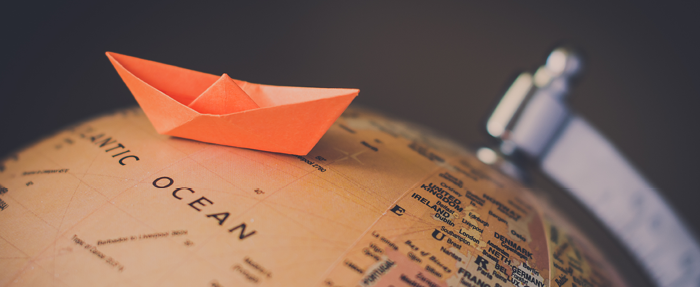
Design, Check. Funding? Nailed it. Prototype? Yup. Importing? Oh, ship.
For entrepreneurs, importing can be a frustrating nightmare of bureaucracy and cryptic acronyms. And pirates. Don’t forget the pirates.
But fear not, intrepid importer. We’re going to get through this together. Sit back as we walk you through what it takes to get your goods from China into the hands of your fawning funders.
Freight Without Restrictions
Make sure your products check out. Many innocuous products are actually hazardous (like exploding hoverboards, Kinder Eggs and more). Fortunately, cargo that could never board a plane can make it on a ship. But hold off crowdfunding a portable nuclear reactor.
Organizations like the Department of Agriculture or the FDA can also pump the brakes on products like cosmetics, leather trim and even wooden shipping pallets. Spend some time making sure your products won’t have surprise fees. A good place to start is with an online duties estimator and the Department of Transportation’s website.
Also, while impressive packaging sells, it can also blow out freight costs, which are determined by size and weight. Ensure that individual products and stacked packaging isn’t wasting space. It adds up.
Start Small, Grasshopper
Importing samples is usually straight-forward (budget $50-$100 for courier shipping). When you’re squared away, get in a trial order of a few boxes before you scale to full containers to make sure that the product quality scales. At this stage, express air cargo may still be the best option. If you’re shipping something big, go with LCL (less-than-container-load ocean).
Freight Minds Think Alike
It’s time to freight forwarder up. Avoid the temptation to save some pennies and do it yourself by independently sourcing trucking companies, carriers and customs. It’s a non-starter; most international carriers won’t even think about playing ball with a small fry, no matter how delicious. Also, don’t blindly agree when manufacturers offer to arrange global shipment – it’s a great way for them to pad margins.
Finding the right forwarder usually begins with some recommendations, followed by a freight quote request from forwarders. Here’s three things to bear in mind:
1. The Acronyms
Forwarders will ask what terms (or incoterms) you’re shipping with. The Big Three for you are:
- Ex-Works (EXW): Your forwarder will arrange for full shipping from factory to your door.
- Free Carrier (FCA): For less-than-container-load shipments, your supplier can arrange for shipment to get to the port, where it’s consolidated into containers. The supplier will pay for transport to the port and local customs, with your forwarder covering everything else, including some remaining export charges.
- Free On Board (FOB): This is just like FCA except the supplier also pays the remaining export country charges. With FCA and FOB, you’ll pay your forwarder to handle international transit and all the charges within the destination country.
2. Mode ala Mode
Forwarders will ask whether you’re shipping by air (fast but expensive) or ocean (s-l-o-w and cheap). As a rule of thumb, if your shipment is under 1,000 lbs or so, it may be cheaper to úse air freight. It’s also quicker – air freight from China to the US takes about 8-10 days,while ocean freight takes 30-40 days. You can use this freight calculator to get an idea of what works better for you.
Ship Happens; Insurance Up
While most carriers provide a basic level of insurance but it’s usually completely insufficient. Request cargo insurance and ask specifically for comprehensive insurance, which will keep you covered – it’s worth the investment.
Choosing the Perfect Forwarder
Be picky, often.Freight is complicated and getting the right guidance is important, as is finding someone who will help you troubleshoot shipping issues as they arise in real-time. Make sure you find the perfect provider.
Start with quotes from multiple forwarders to compare prices and service. A great starting point is referrals from friends who have shipped before. More and more global forwarders offer quotes online (like K+N or UPS Air), while online comparison tools like the Freightos Marketplace help too.
Once you choose the forwarder, get your supplier to email you the packing list. Then collect:
- Supplier and Buyer contact details and pickup/delivery addresses
- Total weight and dimensions of every box or pallet (hint, it’s in the packing list)
- Product description (ask your supplier for the HS code – essentially a global ID for different products!)
- Value of shipped goods and date of shipment
Stick in there, champ, you’re almost done.
The Start of a Beautiful Relationship
Houston, prepare for paperwork. Your forwarder will take you through the documents, like the commercial invoice and Power of Attorney. Spend time doing it right as errors are costly. For instance, US Customs will prevent clearance if document wording doesn’t line up to the letter, which means exploding costs.
Dotted your t’s and crossed your i’s? You’re good to go.
The paper process of documentation and clearances will be controlled by the forwarder, while the shipment process will be controlled by several carriers and the customs process at each end will be controlled by Customs. Unlike Amazon, it’s not always as easy to track your shipments, which means more time than you want following up by phone.
The Finish Line
Monumentally boring volumes can be written about freight (and are) but, hey, you’re a crowdfunded genius. You got this. And if you followed these instructions, it will take you less time.
Which means more time to do what you love.
Which means more products to develop.
Which means…more importing.
Meta.
John Edmonds is a logistics expert who loves writing about freight (who doesn’t) at Freightos. When he’s not, he enjoys Miso Soup, cats and cricket (the game, not the insect).
Frieghtos loves makers – Indiegogo’ers can get $100 off their first international import (minimum of $1,000 order) with their first Freightos shipment. Sign up free here.


